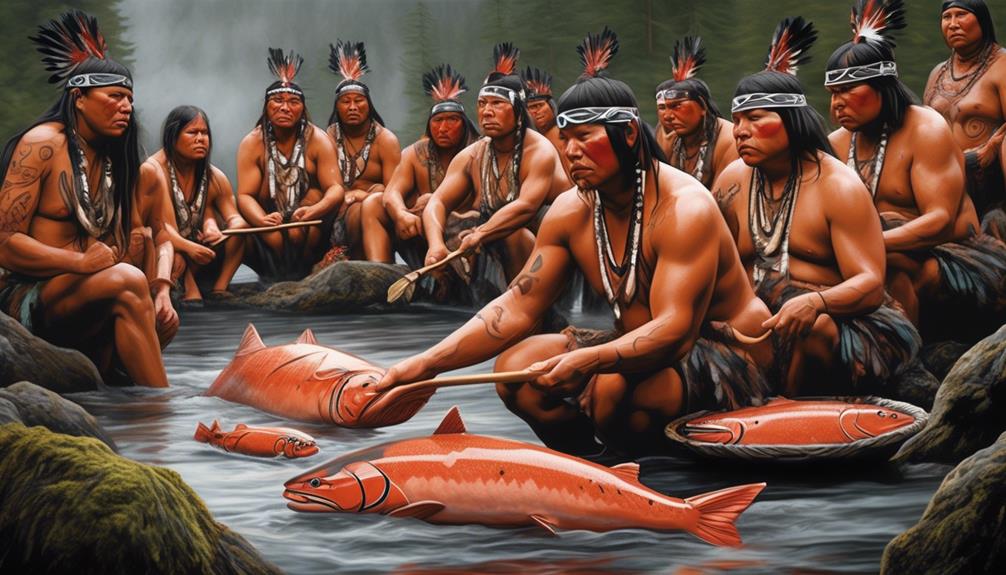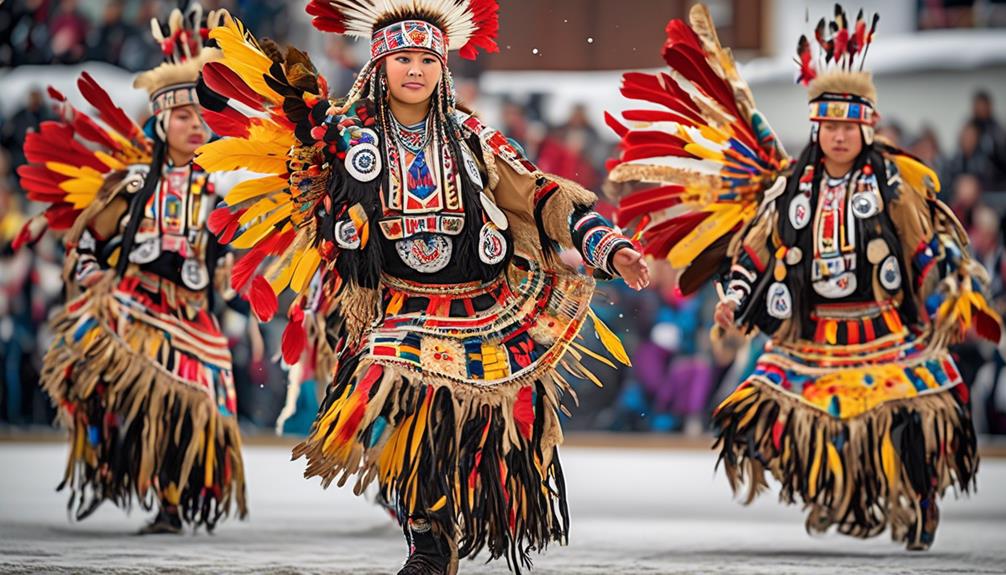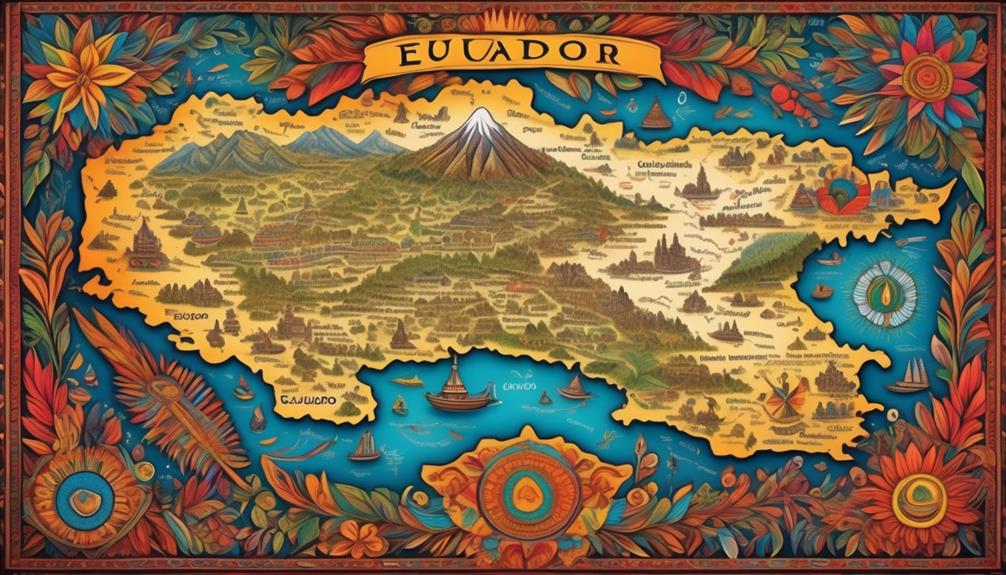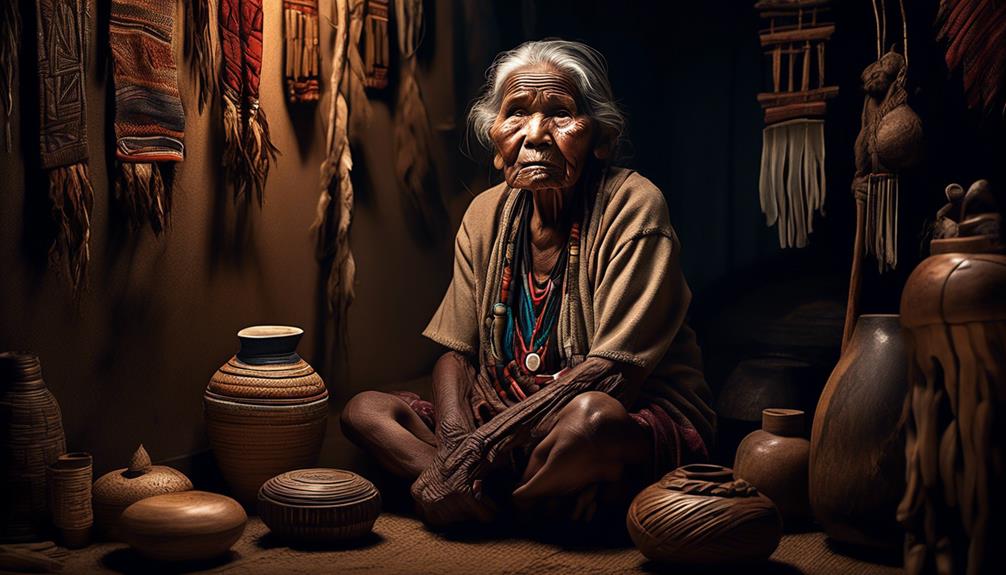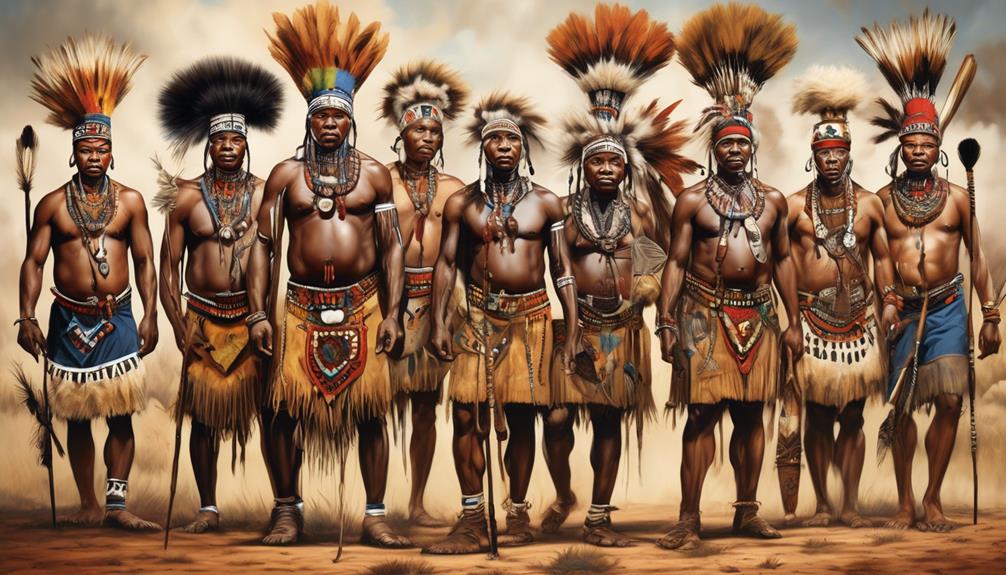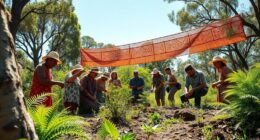In the Pacific Northwest, the tradition of cedar weaving is as ancient as the towering trees that inspire its durability. Just like the cedar trees that brave the elements, this cultural custom endures among the indigenous peoples of the area.
The intricate art of cedar weaving, passed down through generations, holds a deep cultural significance and plays a vital role in preserving the stories and values of the indigenous peoples.
As we explore the techniques, materials, and contemporary relevance of this tradition, we uncover a rich tapestry of heritage that continues to thrive amidst the complexities of modern society.
Key Takeaways
- Cedar weaving is a tradition of Pacific Northwest Indigenous people that still survives today.
- Cedar weaving embodies cultural heritage and spirituality, reflecting the resilience and strength of Indigenous peoples.
- The traditional weaving techniques and use of cedar as a revered natural material play a significant role in preserving cultural identity and connection to the land.
- The tradition of cedar weaving is actively passed down through generations, with elders teaching younger community members to ensure the preservation and revitalization of cultural practices.
Origins of Cedar Weaving
The tradition of cedar weaving has been passed down through generations among the Indigenous peoples of the Pacific Northwest, playing a vital role in our cultural heritage and connection to the natural world. Cedar weaving history is rich and complex, dating back centuries. The practice of weaving cedar has been a cornerstone of our traditional practices, serving both practical and spiritual purposes.
Our ancestors skillfully harvested cedar, honoring the tree's spirit and using every part with respect. They employed traditional techniques to prepare the cedar bark, often soaking and stripping it by hand. This process required patience and precision, reflecting the deep reverence for the natural materials.
Cedar weaving has been integral to our cultural identity, shaping our material culture and artistic expressions. The intricate patterns and designs woven into baskets, hats, and mats carry stories of our people, reflecting the interconnectedness of all living beings. Through these traditional practices, we maintain a profound connection to our ancestors and the natural world, preserving our rich heritage for future generations.
Cultural Significance
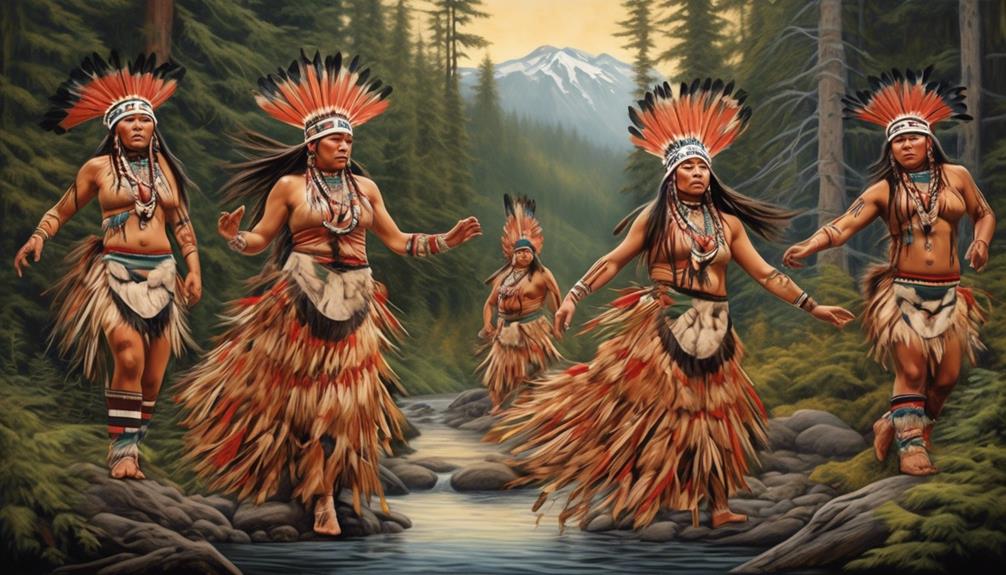
Passed down through generations, cedar weaving holds immense cultural significance for the Indigenous peoples of the Pacific Northwest, embodying our deep connection to tradition and the natural world.
Cedar weaving is more than just a craft; it's a form of artistic expression that reflects our cultural heritage, spirituality, and identity. The intricate patterns and designs woven into cedar items carry stories of our ancestors, symbolizing resilience and strength in the face of adversity.
Furthermore, cedar weaving is a cornerstone of community celebration, bringing people together to honor and preserve our traditions. Through workshops and gatherings, we pass on this ancient art form, fostering a sense of belonging and pride within our community.
Moreover, cedar weaving strengthens family connections, as knowledge and techniques are shared between generations, reinforcing bonds and nurturing a sense of belonging.
As we continue to practice and teach cedar weaving, we ensure that our cultural heritage remains vibrant and enduring, shaping our identity and fostering a deep connection to our roots.
Techniques and Materials
Indigenous peoples of the Pacific Northwest employ traditional weaving techniques and utilize cedar, a revered natural material, to create intricate and culturally significant items. The use of natural resources, particularly cedar, is deeply intertwined with our artistic expression. Cedar holds immense cultural significance for us, as it's seen as a gift from the Creator, providing us with the raw materials to craft a wide array of items that serve both practical and ceremonial purposes.
Our traditional weaving techniques, passed down through generations, allow us to create baskets, hats, and regalia that showcase our rich cultural heritage and artistic prowess.
The process of gathering and preparing cedar is a sacred practice, requiring careful stewardship of the environment and a deep respect for the natural world. Once harvested, cedar is meticulously crafted using age-old techniques, ensuring that each item reflects the skill and artistry of its maker.
The artistic expression embedded in these creations serves as a testament to the enduring traditions of Pacific Northwest Indigenous peoples, preserving our cultural identity and connection to the land.
Role in Contemporary Indigenous Communities
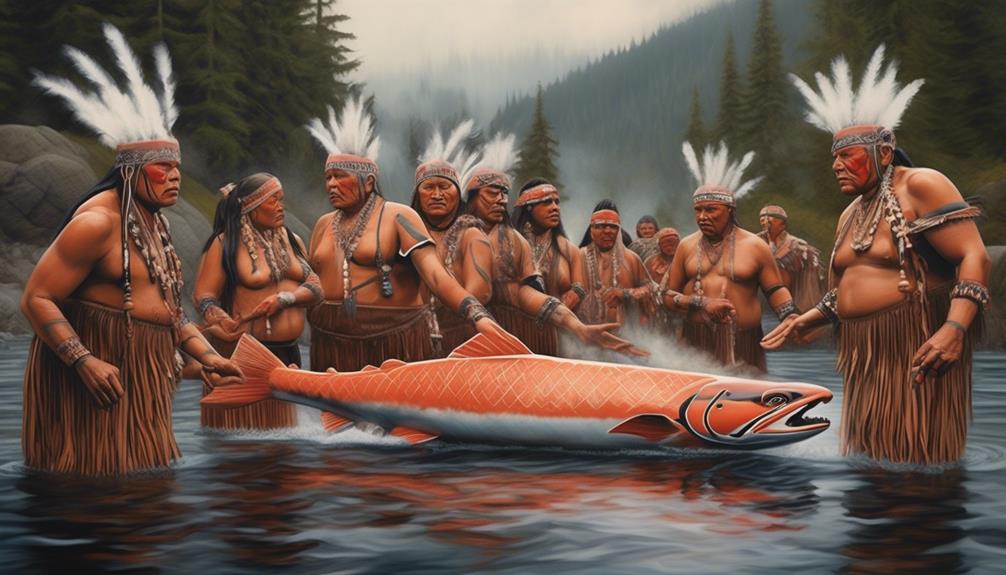
Embedded within our contemporary Indigenous communities, our traditional weaving techniques and the use of cedar continue to play a vital role in preserving our cultural heritage and sustaining our artistic expression. We uphold our traditions through community involvement, passing down knowledge from elders to younger generations, and fostering a sense of shared identity and pride in our cultural practices. Additionally, our weaving techniques have found modern applications, such as creating contemporary clothing, accessories, and artistic pieces that aren't only valued within our communities but also appreciated by a broader audience.
- Community involvement: Our traditional weaving and cedar work often involve collective efforts, bringing community members together for collaborative projects and cultural events.
- Passing down knowledge: Elders actively engage in teaching the younger generation about traditional techniques, ensuring the preservation and continuation of our cultural practices.
- Modern applications: Our weaving techniques and cedar work have evolved to incorporate modern designs and purposes, contributing to the sustainability and relevance of our traditions in today's world.
Preservation and Revitalization Efforts
Preserving and revitalizing our traditional weaving techniques and the use of cedar remains paramount in ensuring the continued vibrancy of our cultural heritage and artistic expression within contemporary Indigenous communities. Preservation efforts are crucial as they not only safeguard our ancestral knowledge but also contribute to the resilience and empowerment of our people.
Through community-led initiatives, we're actively working to document and transmit these age-old practices to the younger generations, ensuring that our traditions remain alive and thriving. The impact of these preservation efforts extends beyond cultural significance; it fosters a sense of belonging and pride within our community, strengthening our collective identity.
Moreover, the revitalization of traditional weaving and cedar use has far-reaching effects, creating opportunities for economic sustainability and intergenerational knowledge transfer. By integrating these practices into modern artistic expressions and entrepreneurial endeavors, we're able to preserve our heritage while simultaneously adapting to the contemporary world.
The community impact of these efforts is profound, fostering a sense of unity and shared purpose. As we continue to uphold and revitalize our traditions, we aren't only honoring our ancestors but also laying the foundation for a vibrant and culturally rich future.
Frequently Asked Questions
How Does Cedar Weaving Play a Role in the Spiritual Beliefs and Practices of Pacific Northwest Indigenous People?
Cedar weaving holds a significant role in the spiritual beliefs and practices of Pacific Northwest Indigenous people. It embodies cultural preservation and carries deep spiritual significance.
Despite contemporary adaptations, the tradition faces challenges in revitalization. The art of cedar weaving is a vital link to our ancestral heritage, connecting us to our past and guiding us into the future.
Its preservation is essential to maintaining the spiritual and cultural identity of our community.
Are There Specific Rules or Protocols That Must Be Followed When Harvesting Cedar for Weaving Purposes?
When harvesting cedar for weaving, specific protocols must be followed, respecting its cultural significance and sustainability practices. These protocols ensure the continuation of this artistic expression.
It's essential to honor the land and the tree, taking only what's needed and giving back to maintain balance.
Understanding and respecting these traditions is crucial for the preservation of this ancient practice and the well-being of our environment.
What Are Some of the Different Patterns and Designs Used in Cedar Weaving, and Do They Have Specific Meanings or Symbolism?
Meaningful patterns and symbolic designs are integral to cedar weaving among Pacific Northwest Indigenous people. Each pattern holds deep cultural significance, often representing elements from nature or conveying traditional stories and teachings.
The intricate designs reflect our rich heritage and spiritual connection to the natural world. Understanding these patterns requires a profound appreciation for our cultural traditions and the timeless wisdom they embody.
How Has the Practice of Cedar Weaving Evolved and Adapted Within Contemporary Indigenous Communities?
Evolution and innovation have shaped the practice of cedar weaving within contemporary indigenous communities. It holds cultural significance and sustains our traditions.
We've adapted traditional techniques to create modern designs, ensuring the art form thrives. Our commitment to sustainability drives us to use eco-friendly materials and methods.
These changes honor our heritage while embracing the present, keeping our ancestral traditions alive and relevant in today's world.
What Are Some of the Challenges Faced in Preserving and Revitalizing Traditional Cedar Weaving Techniques and Knowledge Within Pacific Northwest Indigenous Communities?
Preservation challenges can be daunting, but our community's commitment to cultural significance fuels our efforts.
Revitalization is a shared mission, with each member playing a vital role. We acknowledge the hurdles, yet our resolve remains unwavering.
Community involvement fosters a sense of pride and ownership, ensuring the survival of traditional cedar weaving techniques and knowledge.
Together, we embrace the past to shape a vibrant future.
Conclusion
In conclusion, the art of cedar weaving is a living thread that weaves together the past, present, and future of Pacific Northwest indigenous people. Like the sturdy cedar tree, this tradition stands tall, connecting generations and preserving cultural identity.
Its intricate patterns and vibrant colors create a vibrant tapestry of resilience and strength, reminding us of the enduring spirit of indigenous communities.
As we continue to nurture and honor this tradition, we ensure that its roots run deep and its branches reach high.
